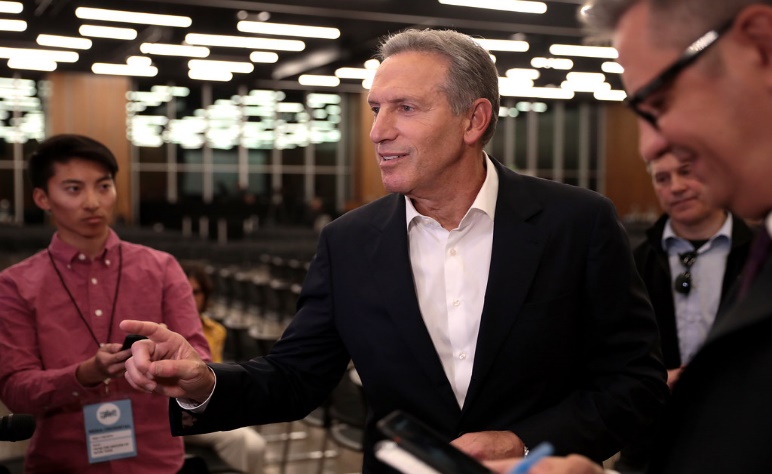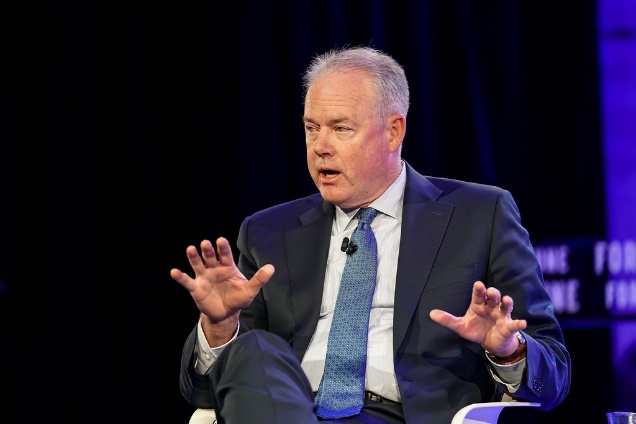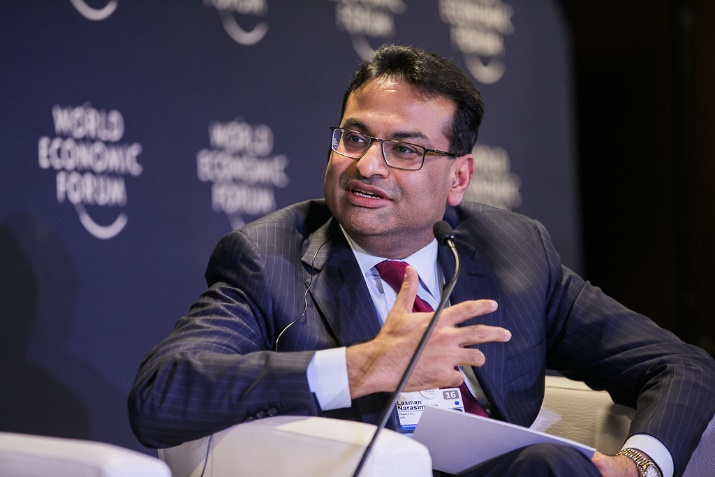United States Securities and Exchange Commission
Washington, D.C. 20549
NOTICE OF EXEMPT SOLICITATION
Pursuant to Rule 14a-103
Name of the Registrant: Starbucks Corporation
Name of persons relying on exemption: National Legal and Policy Center
Address of persons relying on exemption: 107 Park Washington Court, Falls Church, VA 22046
Written materials are submitted pursuant to Rule 14a-6(g) (1) promulgated under the Securities Exchange Act of 1934. Submission is not required of this filer under the terms of the Rule but is made voluntarily in the interest of public disclosure and consideration of these important issues.

PROXY MEMORANDUM
TO: Shareholders of Starbucks Corporation
RE: The case for voting AGAINST Howard Schultz as a nominee for the Board of Directors on the 2023 Proxy Ballot.
This is not a solicitation of authority to vote your proxy. Please DO NOT send us your proxy card; National Legal and Policy Center is not able to vote your proxies, nor does this communication contemplate such an event. NLPC urges shareholders to vote for Proposal No. 9 following the instructions provided on management's proxy mailing.
The following information should not be construed as investment advice. Please read full disclaimer information after the end of this report.
National Legal and Policy Center (“NLPC”) urges shareholders to vote AGAINST Howard Schultz (Proposal No. 1, “Election of Directors”, item 1h) on the 2023 proxy ballot of Starbucks Corporation (“Starbucks” or the “Company”).
1
As Starbucks transitions Howard Schultz out as CEO, with Laxman Narasimhan succeeding him, it is time for the Company to move on completely from its iconic leader. This would allow its new top executive to operate outside Mr. Schultz’s shadow, which will enable him to more fully utilize his own skills and make his own judgments, so that the multinational coffee chain can reassess its position and direction at this critical moment in its history.
Shareholders should consider the following when it votes as to whether Mr. Schultz should continue on the Starbucks board of directors:
-There is potential for Mr. Schultz to reclaim the CEO role.
-Mr. Schultz has significant influence over the company and the leadership team, reducing the autonomy and influence of the incoming CEO.
-Starbucks should consider new business strategies apart from those that Howard Schultz introduced during his tenure as CEO, and even as an outside influencer upon the Company.
There is potential for Howard Schultz to reclaim the CEO role in the short-term.
|
| Despite a few efforts by Starbucks leadership to replace Mr. Schultz in the role of CEO, they have been historically short-lived due to his proximity to the Company, as well as the Company’s dependence on him. Mr. Schultz has a long history with Starbucks (Exhibit 1; all exhibits are at the end of the report), and this has created an unhealthy reliance on him for operational and strategic guidance. |
|
|
|
Mr. Schultz’s journey with Starbucks began in 1982 when he joined the company as the director of operations and marketing, quickly understanding the potential for what Starbucks could become. His desire to create a place for human connection, conversation, and communication prompted him to acquire the company outright in 1987 to implement his vision without being obstructed by other owners.1 After a period of significant growth, Mr. Schultz led the company through an initial public offering in 1992 and continued to head the company until his first retirement in 2000 (Exhibit 2). Orin Smith replaced Mr. Schultz as CEO in 2000, and was then replaced by Jim Donald in 2005.2 Mr. Donald was president and CEO until the Great Recession, which marred the company’s financial trajectory and reintroduced Mr. Schultz into the company’s C-suite. | ||
1 “Starbucks case for structured decision-making”, Academy of Competitive Intelligence, January 4, 2017. See https://academyci.com/wp-content/uploads/2020/01/Starbucks-case-for-Structured-2019.pdf.
2 Ibid.
2
Despite quadrupling its store count (Exhibit 3) and revenue, while increasing its pre-tax profit margin from 7.4 percent to 11.2 percent, Starbucks was in trouble during the recession, as the company depended on store growth to support the slowing profitability of existing stores.3 After arguing to the board of directors that Starbucks was sacrificing store culture and the customer experience to boost margins, growth, and profitability,4 the company fired Mr. Donald and reappointed Mr. Schultz as CEO and chairman of the board in January 2008. During his second term as CEO, which lasted until April of 2017, Mr. Schultz focused on de-commoditizing the Starbucks experience, while expanding Starbucks’s global presence.5 After growing to 25,000 stores across 75 countries, Mr. Schultz retired again and Kevin Johnson took the reins as CEO.6
Mr. Johnson led Starbucks through the troubling 2018 Philadelphia arrests of two African-American men, the COVID-19 pandemic, heightened supply chain issues in the wake of the pandemic, and rising competition across the globe. Mr. Johnson picked up where Mr. Schultz left off and focused on international growth and improving the Starbucks experience by revamping its digital offerings, while continuing to grow the total number of stores (Exhibit 4).7 |
|
|
Mr. Johnson, similar to Mr. Donald, focused on boosting efficiency and speed, causing stores to once again lose touch with its people-centric culture.8 As a result of the compromised Starbucks experience and global pandemic, revenue grew at a 6.7 percent compound annual rate from 2017 to 2021,9 compared to a compound annual revenue growth of 9.4 percent from 2008 to 2017.10 After leading the company through the high-intensity events, Mr. Johnson sensed that his time to retire quickly approached. | ||
Despite Mr. Johnson expressing his desire to retire for over a year, the board of directors scrambled to find a replacement upon his official retirement and named Mr. Schultz as the “interim CEO” upon Mr. Johnson’s departure in April of 2022. After searching for a new CEO for several months, the company announced a successor in Laxman Narasimhan, who will fully
3 “Starbucks Corporation Form 10-K 2016”. SEC EDGAR, November 18, 2016. See https://www.sec.gov/Archives/edgar/.
data/829224/000082922416000083/sbux-1022016x10xk.htm.
4 J. Hannah, “Starbucks, Reinvented: A Seven-Year Study on Schultz, Strategy And Reinventing A Brilliant Brand,” Forbes, August 25, 2014. See http://www.forbes.com/sites/hbsworkingknowledge/2014/08/25/ starbucks-reinvented/.
5 Ibid.
6 “Starbucks Corporation Form 10-K 2017”. SEC EDGAR, November 17, 2017. See https://www.sec.gov/Archives/edgar/.
7 K. Broughton, “How Starbucks Changed Under Departing CEO Kevin Johnson,” The Wall Street Journal, January 25, 2022. See https://www.wsj.com/articles/how-starbucks-changed-under-departing-ceo-kevin-johnson-11648842009.
8 H. Haddon, “Starbucks is having an identity crisis. Can Howard Schultz fix it?” The Wall Street Journal, April 22, 2022. See https://www.wsj.com/articles/starbucks-can-howard-schultz-fix-it-11650631886.
9 Ibid.
10 “Starbucks Corp (SBUX.OQ) Financials,” Refinitiv, retrieved March 7, 2023. See: https://www.refinitiv.com/en/companies/starbucks-corp/SBUX.OQ/financials.
3
|
| and solely assume the office on April 1, 2023, removing his “interim” tag. Since he was named he has shadowed Mr. Schultz, while going through barista training and familiarizing himself with the company’s operations. Once the role is entirely his, much of Mr. Narasimhan’s success will be determined by his ability to navigate Starbucks through employee unionization efforts, increased crime in and around store locations, growing geopolitical instability, and increasing commercial digitization. |
|
|
|
Mr. Schultz’s proximity to the company as the fifth-largest shareholder, as well as his prospective continuing role as a member of the board, would allow him to seamlessly reassume the CEO position should anything go awry with the company.11 In the past two instances where Mr. Schultz came out of retirement, he was already actively involved in the business’s strategy and vision. His proximity to the company as a director, following his resignation as CEO, would put him and the company in a very familiar situation. Starbucks’s chairwoman Mellody Hobson has said that Mr. Schultz will “have a special voice at the company while holding a regular seat on the board.”12 Despite Mr. Schultz’s claim that he is “never coming back,” we urge Starbucks’s shareholders to oppose Mr. Schultz’s continuation on the board of directors – whose membership is being reduced in number from nine to eight – as the increased influence of his “special voice” could pressure the board to re-evaluate a familiar CEO candidate: Mr. Schultz.13
Howard Schultz has significant influence over the company and the leadership team, reducing the autonomy and influence of the incoming CEO.
The board of directors demonstrated a lack of initiative by not conducting a search for a CEO prior to Mr. Johnson’s formal retirement announcement. According to a CNBC article, Mr. Johnson said, “A year ago, I signaled to the Board that as the global pandemic neared an end, I would be considering retirement from Starbucks. I feel this is a natural bookend to my 13 years with company.”14 The directors’ dependence upon Mr. Schultz as a “visionary” for Starbucks is evidenced by them asking him to come out of retirement to lead the company yet again, despite the board having ample time to evaluate additional candidates. Senior executives at Starbucks have expressed concerns about “the company relying on Mr. Schultz and not having someone else ready to step in when Mr. Johnson had signaled his intent to retire… It’s not sustainable.”15
11 H. Haddon, “New Starbucks CEO to learn role alongside Howard Schultz,” The Wall Street Journal, September 12, 2022. See https://www.wsj.com/articles/new-starbucks-ceo-to-learn-role-alongside-howard-schultz-11662975000.
12 Ibid.
13 D. Wiener-Bronner, “Starbucks’ Howard Schultz: ‘I am never coming back’”, CNN, September 7, 2022. See https://www.cnn.com/2022/09/07/business/howard-schultz-starbucks-ceo/index.html.
14 J. Corba & A. Lucas, “Starbucks CEO Kevin Johnson is retiring, and Howard Schultz is returning as interim chief,” CNBC, March 16, 2022. See: https://www.cnbc.com/2022/03/16/starbucks-ceo-kevin-johnson-is-retiring-howard-schultz-returns-as-interim-chief.html.
15 H. Haddon, “Starbucks is having an identity crisis. Can Howard Schultz fix it?” The Wall Street Journal, April 22, 2022. See https://www.wsj.com/articles/starbucks-can-howard-schultz-fix-it-11650631886.
4
Despite not serving the company in an official capacity, in November of 2021 Mr. Schultz conducted meetings with union officials at Starbucks locations in Buffalo, N.Y., and became increasingly occupied with the challenges Starbucks faced.16 Thus, once confronted with the retirement of Mr. Johnson, Mr. Schultz was the board’s first choice due to his ability to “help steer the company… (during) an inflection point.”17
Ms. Hobson, chairwoman of Starbucks’s board of directors, said the company “need(s) someone who has vision.” For Mr. Narasimhan to succeed, however, Mr. Schultz must take a hands-off approach and give Mr. Narasimhan full autonomy to carry out his vision,18 as “having two visionaries only creates chaos and confusion.”19 We believe the only way for this transition to occur successfully is for Mr. Schultz to fully depart all leadership and advisory positions within the company.
Starbucks should consider new business strategies apart from those that Howard Schultz introduced during his tenure as CEO.
Starbucks-China Relationship
|
| In January of 2021, China Chairman Xi Jinping wrote to Howard Schultz to say that he “hope(s) Starbucks will make active efforts to promote China-U.S. economic and trade cooperation and the development of bilateral relations.”20 The Washington Post believed that Chairman Xi asked Starbucks to lobby for Beijing to Washington and that Mr. Schultz was “wading into dangerous territory… (with) serious strategic, legal, and ethical implications.”21 |
Mr. Schultz has long courted the Chinese government and, in September of 2022, said that “China will overtake America as Starbucks’s biggest market by 2025” and that Starbucks’s “aspirations around China have never been greater.”22 The goals Mr. Schultz has set for the
16 Ibid.
17 Ibid.
18 Ibid.
19 M. Winters, “Can we have two visionaries,” EOS Entrepreneurial Operating System, accessed March 7, 2023. See https://www.cnbc.com/2022/03/16/starbucks-ceo-kevin-johnson-is-retiring-howard-schultz-returns-as-interim-chief.html.
20 I. Stone Fish, “Beijing wants U.S. business leaders to plead its case. Here’s why they shouldn’t.” The Washington Post, January 18, 2021. See https://www.washingtonpost.com/opinions/2021/01/18/beijing-wants-us-business-leaders-plead-its-case-heres-why-they-shouldnt/.
21 Ibid.
22 C. Rainey, “China first: The untold story of how Starbucks has cozied up to the Communist Party in pursuit of explosive growth,” Fast Company, November 15, 2022. See https://www.fastcompany.com/90807718/starbucks-in-china-the-untold-story.
5
company are audacious. They include increasing China store counts from 6,000 to 9,000 and growing the workforce from more than 60,000 to 100,000, while opening the new Innovation Park in the summer of 2023.23 Mr. Schultz’s bet on China is a significant one, especially considering the country’s history of intimidation, coercion, human rights violations, and seizing private companies.24
Starbucks’s Chinese segment has contributed meaningfully to top-line and bottom-line growth, though that growth brings along significant risks and costs, with the stability of the relationship being determined by many factors, including Mr. Schultz’s relationship with the communist-led government. Because of Mr. Schultz’s strong ties to President Xi, evidenced by back-and-forth letters between them, as well as numerous visits between their two countries, he was granted favor with the country’s leaders.25 Should Mr. Narasimhan fail to sustain those strong relationships or deviate from Starbucks’s China growth objectives, the company will likely face backlash from the communist government, as many companies in the past have.26 We would thus suggest that Mr. Narasimhan independently evaluate the company’s prospects before further investment in China due to the significant risks presented for doing business in the communist country.
Employee Unionization
There has been a growing movement of Starbucks employees to unionize. Mr. Schultz has opposed unions since the 1980s when he initially purchased the Company, and he has become further entrenched in his belief, saying that “unions are not the answer.”27 Mr. Schultz has led a series of union-busting campaigns and lobbied against pro-unionization legislation, but the most recent effort of employees to unionize has Mr. Schultz caught in allegations of illegally firing pro-union employees and the illegal closure of pro-union stores.28 |
|
|
The group leading the unionization effort, Starbucks Workers United, has claimed that dozens of workers engaged in organizing efforts have been fired due to their involvement in the labor union, and the National Labor Relations Board has alleged that Starbucks has committed several hundred labor violations.29 On March 2, 2023, a labor judge found that Starbucks wrongfully
23 Ibid.
24 “Proxy Memorandum: Proposal No. 7,” National Legal and Policy Center, Accessed March 8, 2023. See https://www.sec.gov/Archives/edgar/data/1958085/000109690623000495/nlpc_px14a6g.htm.
25 C. Rainey, “China first: The untold story of how Starbucks has cozied up to the Communist Party in pursuit of explosive growth,” Fast Company, November 15, 2022. See https://www.fastcompany.com/90807718/starbucks-in-china-the-untold-story.
26 Ibid.
27 “Starbucks CEO Howard Schultz’s history of union-busting,” More Perfect Union, March 16, 2022. See https://perfectunion.us/starbucks-ceo-howard-schultzs-history-of-union-busting/.
28 Ibid.
29 M. Sainato, “Starbucks creating ‘culture of fear’ as it fires dozens involved in union efforts,” The Guardian, August 25, 2022. See https://www.theguardian.com/us-news/2022/aug/25/starbucks-union-employees-fired.
6
fired several employees and violated labor laws “hundreds of times,” with the presiding judge citing “egregious and widespread misconduct” within the company.30 That caught the attention of Senator Bernie Sanders, who had to threaten Mr. Schultz with a subpoena in order to convince him to testify before his committee.31
At least 289 of the 9,000 U.S. Starbucks locations have voted to unionize, with more likely to follow.32 Mr. Schultz’s scorched-earth effort to be rid of unionization has left a bad taste in the mouths of many employees and other stakeholders, especially considering Starbucks’s stated commitment to ensuring that everyone is “treated warmly” and “with transparency, dignity, and respect.”33 This has opened the Company to serious litigative risk.
Mr. Schultz’s visit with union officials in Buffalo in November of 2021 was intended to sway the stores away from unionizing in an attempt to squelch the movement before it took flight. This visit was conducted while Mr. Schultz did not have an official position within the company. Despite his impending resignation as CEO, it is probable that Mr. Schultz will continue to press his aggressive anti-unionization tactics once he leaves the C-suite. For a company whose culture and values stem from respecting others’ opinions and beliefs, we are surprised that Mr. Schultz has threatened employees by saying, “If you hate Starbucks so much, why don’t you go somewhere else?”34
Politicization of the company
It’s not just dissatisfied Starbucks workers toward whom Mr. Schultz has exhibited a brash willingness to show the door; He has also invited shareholders to disinvest if they don’t like how the Company does business. At the 2013 annual meeting, he was challenged by an investor about the Company’s support for a same-sex marriage referendum in its home state of Washington. Mr. Schultz told the shareholder, “If you feel, respectfully, that you can get a higher return than the 38 percent you got last year, it’s a free country. You can sell your shares of Starbucks and buy shares in another company. Thank you very much.”35
The question isn’t whether the Company, or even the CEO, should support or oppose same-sex marriage, but whether it’s proper for a corporation to take positions on controversial issues when so many of its shareholders are involuntarily invested. As Peter Flaherty, chairman of National Legal and Policy Center, wrote at the time:36
30 “Starbucks violated workers’ rights ‘hundreds of time,’ labor judge says,” Money Watch. See: https://www.cbsnews.com/news/starbucks-violated-worker-rights-union-fight-labor-judge/.
31 D. Wiener-Bronner, “Howard Schultz will testify before senate committee on Starbucks’ labor practices,” CNN, March 7, 2023. See https://www.cnn.com/2023/03/07/business/howard-schultz-testimony/index.html.
32 Ibid.
33 “Culture and Values”, Starbucks. See https://www.starbucks.com/careers/working-at-starbucks/culture-and-values/.
34 J. Zakarin, “Starbucks barista challenges CEO Howard Schultz at airport meeting,” More Perfect Union, April 9, 2022. See https://perfectunion.us/starbucks-barista-challenges-ceo-howard-schultz-at-secret-meeting/.
35 “Starbucks CEO Howard Schultz defends company's stance on same-sex marriage to anti-gay activist,” DailyMail.com, March 24, 2013. See https://www.dailymail.co.uk/news/article-2298637/Howard-Schultz-Starbucks-CEO-video-defending-company-anti-gay-activist.html.
36 Flaherty, Peter. “I’ve Had My Last Cup of Starbucks Coffee,” National Legal and Policy Center, March 27, 2013. See https://archive.nlpc.org/2013/03/27/ive-had-my-last-cup-starbucks-coffee/.
7
Institutional investors now own the majority of shares of publicly-held companies traded on U.S. exchanges. Many people own stock through mutual and pension funds, overseen by professional managers. As a practical matter, lots of Starbucks shareholders do not have the opportunity to easily sell their stock.
But there is a larger issue. Why is one of the world’s biggest and most widely admired companies taking sides on such a controversial issue? If Schultz can tell shareholders who disagree with him to take a hike, doesn’t this necessarily extend to customers, partners and employees? After all, these relationships are voluntary, too…
Homosexual marriage is not just another public policy issue. It reaches deeply into the realms of personal morality and religion. As an individual, Schultz is entitled to his views. It is a free country. But as a corporate executive, does he really have the right to obligate everyone else at the company to his beliefs?
If Starbucks as a company now formally supports gay marriage and is committing corporate resources to the fight, does this not create a dilemma for many employees?
|
| Mr. Schultz has not hesitated to improperly use the Company’s might and influence to weigh in on other divisive political issues. In 2016, he signed Starbucks on to an effort to oppose a law in North Carolina that prohibited the coercion of private businesses to accommodate the use of women’s restrooms and locker rooms by biological males who claim to be “transgender.”37 |
|
| |
| The following year Mr. Schultz pledged to hire 10,000 “refugees” in response to an | |
executive order by then-President Trump to temporarily prohibit visits from citizens of seven nations that showed a heightened terror threat to the United States. That unpopular move by Mr. Schultz for a time diminished the Company’s image in the eyes of the public.38 | ||
And in 2018, following the arrest of two black men at a Philadelphia Starbucks because they refused to leave when asked by a manager and the Company was accused of racism because of it, Mr. Schultz temporarily closed nearly 8,000 stores involving about 175,000 employees for “racial-bias education,” despite the fact that only one Starbucks employee caused the incident. A subsequent “Third Place Policy” that opened the restaurants’ restrooms to anyone regardless of whether they made purchases created a nightmare at many locations of unauthorized and illegal activities, drawing homeless people and drug abusers who often refused to leave. This led to the
37 Chesser, Paul. “Apple, Google, Etc. Bully NC Over Restroom Access,” National Legal and Policy Center, March 31, 2016. See https://archive.nlpc.org/2016/03/31/apple-google-etc-bully-nc-over-restroom-access/.
38 Chesser, Paul. “Starbucks’ Refugees Move Costs Them With Customers,” National Legal and Policy Center, Feb. 24, 2017. See https://archive.nlpc.org/2017/02/24/starbucks-refugees-move-costs-customers/.
8
closure of several stores because of uncontrollable, rampant crime that created unsafe conditions.39
These are just a few examples of the politicization of Starbucks under the progressive steering of Mr. Schultz. In 2019 he made very public gestures and statements about possibly running for President of the United States, which reportedly gave Company executives and board members heartburn because of the potential to entwine his campaign with the identity of Starbucks.40 While the board only need to look in the mirror for allowing Mr. Schultz to politicize the Company, if they truly want to restore at least a perception of moderation, he should be permanently and completely sent to retirement, and kept off an even smaller planned board of directors, which will only further amplify his voice.
Conclusion
Mr. Schultz has a long history with Starbucks, beginning in 1982, but the time has come for Starbucks to look to the future and let the next visionary take the reins. Since developing the initial culture and vision of Starbucks, Mr. Schultz has been the Company’s primary guide despite not always holding an official role. This is a key factor in why the board asked him to come out of retirement twice. The directors failed to find and develop a new leader, thus furthering their reliance on Mr. Schultz during inflection points and financial distress.
To become the next visionary for Starbucks, Mr. Narasimhan needs to develop and implement strategy without Mr. Schultz constantly looking over his shoulder like he has with former CEOs. A similar situation played out in 2022 at The Walt Disney Company, where a lingering former CEO undermined his successor and ultimately ran him off, which led to a disastrous year image-wise and the worst performance of its stock price since the 1970s.41
We believe that Mr. Schultz being removed from all leadership and advisory roles within the company would be the most effective transition. Additionally, given Mr. Schultz’s insistence on exponential growth in risk-laden communist China; his dubious and likely illegal anti-union tactics; and his harmful politicization of the Company, we believe that his complete removal would be beneficial for the development of Mr. Narasimhan and growth of Starbucks.
39 Cortes, Gabriel. “These are the 16 U.S. stores that Starbucks is set to close because of safety concerns,” CNBC, July 14, 2022. See https://www.cnbc.com/2022/07/14/starbucks-is-set-to-close-these-16-us-stores-over-safety-concerns.html.
40 Chesser, Paul. “Time for Starbucks to Break With Schultz’s Left-Wing Politics,” National Legal and Policy Center, July 30, 2018. See https://archive.nlpc.org/2018/07/30/time-for-starbucks-to-break-with-schultz-left-wing-politics/.
41 Flint, Joe; Whelan, Robbie; Schwartzel, Erich; Glazer, Emily; & Toonkel, Jessica. “Bob Iger vs. Bob Chapek: Inside the Disney Coup,” The Wall Street Journal, Dec. 17, 2022. See https://www.wsj.com/articles/bob-iger-bob-chapek-disney-coup-11671236928.
9
Exhibit 142
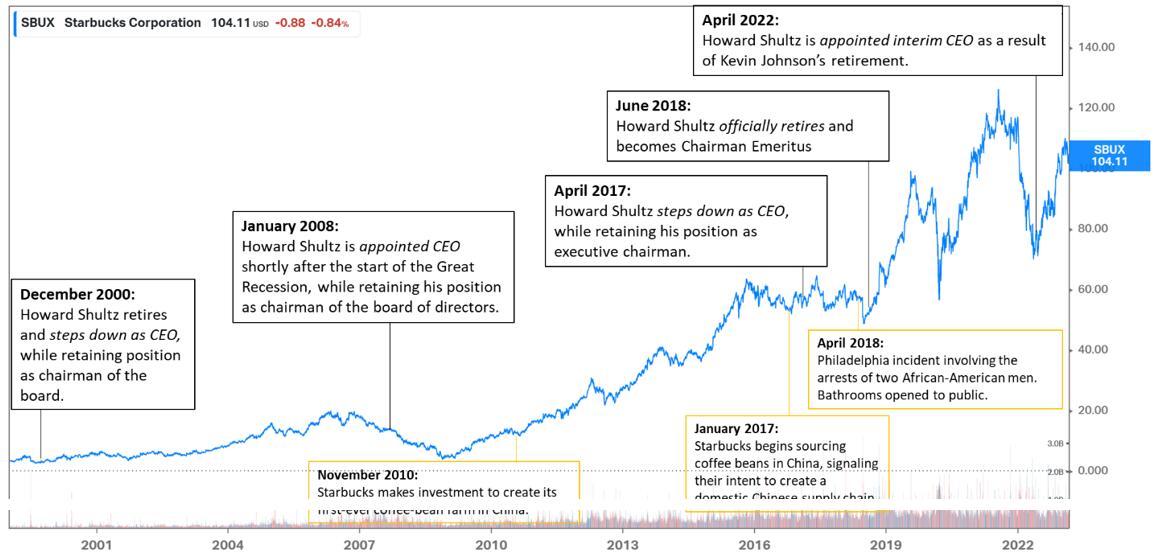
Exhibit 243

42 “Starbucks: Historical Graph,” Koyfin, Accessed March 7, 2023. See https://app.koyfin.com/chart-template/d6a27a25-5b82-43e1-bb6c-4bfde305d781/eq-g2tagw.
43 H. Haddon, “Starbucks is having an identity crisis. Can Howard Schultz fix it?” The Wall Street Journal, April 22, 2022. See https://www.wsj.com/articles/starbucks-can-howard-schultz-fix-it-11650631886.
10
Exhibit 344

Exhibit 445
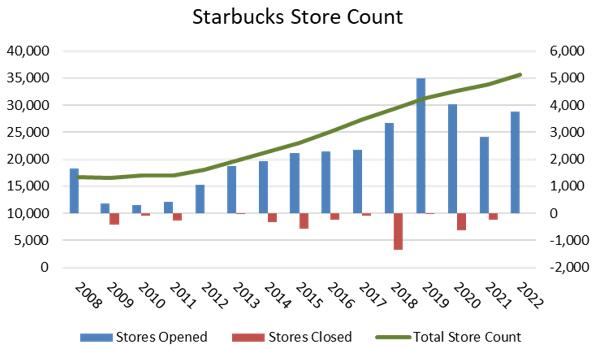
44 “Starbucks case for structured decision-making”, Academy of Competitive Intelligence, January 4, 2017. See https://academyci.com/wp-content/uploads/2020/01/Starbucks-case-for-Structured-2019.pdf.
45 “Starbucks Corp (SBUX.OQ) Operating Metrics,” Refinitiv, retrieved March 7, 2023. See: https://www.refinitiv.com/en/companies/starbucks-corp/SBUX.OQ/financials.
11
Photo credits:
Page 2 – Howard Schultz, Gage Skidmore/Creative Commons
Page 3 – Kevin Johnson, Fortune Global Forum/Creative Commons
Page 4 – Laxman Narasimhan, World Economic Forum/Creative Commons
Page 5 – Xi Jinping, UN Geneva/Creative Commons
Page 6 – Pro-union protest against Starbucks in Philadelphia, joepiette2/Creative Commons
Page 8 – Howard Schultz, Gage Skidmore/Creative Commons
THE FOREGOING INFORMATION MAY BE DISSEMINATED TO SHAREHOLDERS VIA TELEPHONE, U.S. MAIL, E-MAIL, CERTAIN WEBSITES AND CERTAIN SOCIAL MEDIA VENUES, AND SHOULD NOT BE CONSTRUED AS INVESTMENT ADVICE OR AS A SOLICITATION OF AUTHORITY TO VOTE YOUR PROXY.
THE COST OF DISSEMINATING THE FOREGOING INFORMATION TO SHAREHOLDERS IS BEING BORNE ENTIRELY BY THE FILERS.
THE INFORMATION CONTAINED HEREIN HAS BEEN PREPARED FROM SOURCES BELIEVED RELIABLE BUT IS NOT GUARANTEED BY US AS TO ITS TIMELINESS OR ACCURACY, AND IS NOT A COMPLETE SUMMARY OR STATEMENT OF ALL AVAILABLE DATA. THIS PIECE IS FOR INFORMATIONAL PURPOSES AND SHOULD NOT BE CONSTRUED AS A RESEARCH REPORT.
PROXY CARDS WILL NOT BE ACCEPTED BY US. PLEASE DO NOT SEND YOUR PROXY TO US. TO VOTE YOUR PROXY, PLEASE FOLLOW THE INSTRUCTIONS ON YOUR PROXY CARD.
For questions regarding Starbucks Corporation – Proposal #1h – the case for voting AGAINST Howard Schultz for the Company board of directors, by National Legal and Policy Center, please contact Paul Chesser, director of NLPC’s Corporate Integrity Project, via email at pchesser@nlpc.org.
12
